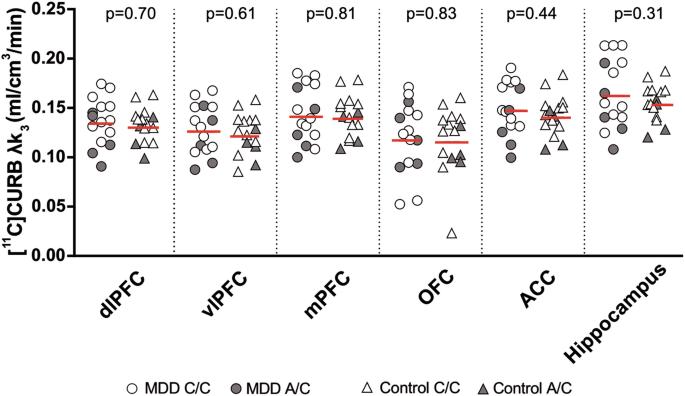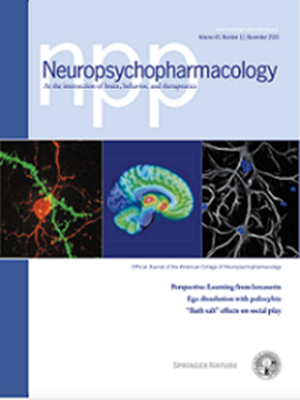Fatty acid amide hydrolase in major depressive episodes: A [11C]CURB positron emission tomography study
IF 6.6
1区 医学
Q1 NEUROSCIENCES
引用次数: 0
Abstract
The role of the endocannabinoid system (ECS) in major depressive disorder (MDD) is under-investigated despite reports of increased activity and/or concentration of fatty acid amide hydrolase (FAAH), a key ECS enzyme, in fronto-limbic brain regions in some animal models of depressive behavior. We hypothesized that [11C]CURB λk3, an index of FAAH density, would be elevated in the prefrontal cortex, hippocampus, and anterior cingulate cortex in major depressive episodes of MDD compared to healthy controls. Fifteen unmedicated MDD participants and 15 age- and sex-matched healthy controls underwent [11C]CURB positron emission tomography and FAAH genotyping. Psychological tests of depressive severity, apathy, and anxiety were administered and measurements were assessed as covariates in exploratory analyses. No significant group differences in [11C]CURB λk3 were observed between MDD participants and controls (F1,27 = 0.32; p = 0.58). A mixed effects model revealed that Marin Apathy Evaluation Scale scores in the MDD group had a significant main effect on [11C]CURB λk3 binding across the collective regions of medial prefrontal cortex, orbitofrontal cortex, anterior cingulate cortex, ventral striatum, and midbrain (F1,11 = 6.75; p = 0.02). Depressive severity and anxiety did not have a significant relationship to [11C]CURB λk3 binding. The relationship of greater fronto-limbic [11C]CURB λk3 to greater apathy along with the metabolic role of FAAH in the ECS, the latter which supports maintaining feelings of interest, initiative, and motivation, has important implications for the pathophysiology of apathy in MDD.

脂肪酸酰胺水解酶在重度抑郁发作中的作用:A [11C]CURB正电子发射断层扫描研究。
内源性大麻素系统(ECS)在重度抑郁症(MDD)中的作用尚未得到充分研究,尽管有报道称,在一些抑郁行为的动物模型中,脂肪酸酰胺水解酶(FAAH)的活性和/或浓度增加。我们假设[11C]CURB λk3 (FAAH密度指数)在重度抑郁发作的MDD患者的前额叶皮质、海马和前扣带皮质中与健康对照相比会升高。15名未服药的MDD参与者和15名年龄和性别匹配的健康对照者接受了[11C]CURB正电子发射断层扫描和FAAH基因分型。进行抑郁严重程度、冷漠和焦虑的心理测试,并将测量结果作为探索性分析的协变量进行评估。MDD参与者与对照组在[11C]CURB λk3上无显著组间差异(F1,27 = 0.32;p = 0.58)。混合效应模型显示,MDD组Marin冷漠评价量表得分对内侧前额叶皮质、眶额叶皮质、前扣带皮质、腹侧纹状体和中脑集体区域的[11C]CURB λk3结合具有显著的主效应(F1,11 = 6.75;p = 0.02)。抑郁严重程度和焦虑与[11C]CURB λk3结合无显著关系。额缘大区[11C]CURB λk3与更大冷漠的关系,以及FAAH在ECS中的代谢作用,后者支持维持兴趣、主动性和动机的感觉,对MDD中冷漠的病理生理具有重要意义。
本文章由计算机程序翻译,如有差异,请以英文原文为准。
求助全文
约1分钟内获得全文
求助全文
来源期刊

Neuropsychopharmacology
医学-精神病学
CiteScore
15.00
自引率
2.60%
发文量
240
审稿时长
2 months
期刊介绍:
Neuropsychopharmacology is a reputable international scientific journal that serves as the official publication of the American College of Neuropsychopharmacology (ACNP). The journal's primary focus is on research that enhances our knowledge of the brain and behavior, with a particular emphasis on the molecular, cellular, physiological, and psychological aspects of substances that affect the central nervous system (CNS). It also aims to identify new molecular targets for the development of future drugs.
The journal prioritizes original research reports, but it also welcomes mini-reviews and perspectives, which are often solicited by the editorial office. These types of articles provide valuable insights and syntheses of current research trends and future directions in the field of neuroscience and pharmacology.
 求助内容:
求助内容: 应助结果提醒方式:
应助结果提醒方式:


